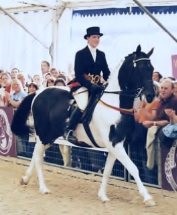 |
| Leo, winning HOYS in 1998. Photo credits Real Time Imaging |
Back To
Reality… For Now
 Once Leo returned home after Arena UK, he settled back into
his normal routine, enjoying his SPILLERS® Senior Conditioning Mix feed alongside
summer turnout. Leo was also kept busy as a total of 6 mares were covered and
in foal by him over the summer.
Once Leo returned home after Arena UK, he settled back into
his normal routine, enjoying his SPILLERS® Senior Conditioning Mix feed alongside
summer turnout. Leo was also kept busy as a total of 6 mares were covered and
in foal by him over the summer.
Goodbye
Summer, Hello Autumn!
As autumn approached our thoughts turned towards preparing
Leo for his Olympia performance. Leo’s skin and coat condition had improved
immensely since changing his diet to SPILLERS® Senior Conditioning Mix, and it
was time to decide whether to clip him. Of course, we wanted Leo to look his
best at Olympia and as his new and improved coat was so healthy and glossy, we
decided to not have him clipped. Unfortunately for us, Leo enjoys nothing more
than a mud bath which meant that we were leading in a brown horse from the
field rather than a coloured!
As the fields became continually wetter, Leo’s turnout had
to be cut down. In order to keep him in shape for Olympia, Bethany and I had
decided that Leo would benefit from some gentle exercise and hacking seemed
like the ideal workout. Both Beth and Leo really enjoy their hacks and it is
lovely to see Leo’s ears pricked forward every time they leave the yard. Even
after being out of ridden work for more than 2 years, Leo still has the same
enthusiasm as he did when he hunted! The new riding jacket provided by SPILLERS®
has also come in handy as Beth looks very smart when out hacking!
Leo’s
Leading Weeks Until Olympia
Leo’s recipe for success now involves a daily routine of
the following exercises:
·
A leg stretch in the field.
·
A gentle hack round the lanes with Bethany.
·
Some in hand showing practice. Trotting a figure
of 8 seems to be Leo’s strong point, although Beth sometimes struggles to keep
up with his strides!
·
A 20 minute groom.
·
A hot oil rub down for his coat.
·
Moisturising spray on his mane and tail before
being rugged up ready for bed.
To ensure that Leo is always as snug as a bug in a rug,
our friend Maralyn had kindly made him an under blanket made of double
thickness moleskin fleece which we always use under his rugs.
 |
| Beth, 6 months old at HOYS 1998. |



























